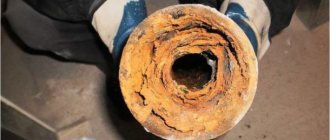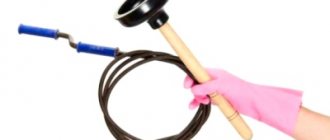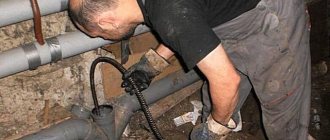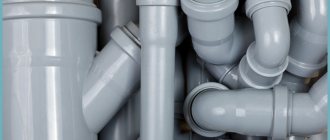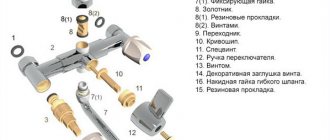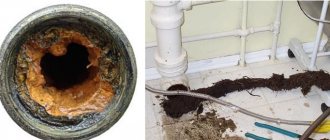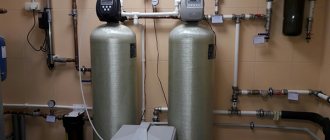Of all the household problems that home and apartment owners have to fix, clogged drains are the most common; the kitchen sink and bathtub are equally likely to become clogged. To effectively solve the problem of what to do when the water in the bathroom does not drain, you should know the causes of blockages in order to prevent them, folk, traditional and modern high-tech cleaning methods.
As a rule, any owner can deal with sewer blockage on his own without calling a plumber thanks to mechanical devices and modern chemicals. Unlike a clogged sewer riser, which causes emergency situations with the inability of all residents along the riser to use the sewer system, the lack of drainage from the bathroom is not so catastrophic and can be eliminated gradually over a certain period of time.
Connecting the bath to the sewer
Causes of blockages in the bathtub and their types
Unlike the kitchen sink, in which dishes with food particles are constantly washed, the bathtub becomes clogged much less often for the following reasons:
- The main source of blockage, in which the water in the bathroom does not drain well, is women's long hair that gets into the pipes from the siphon grid, which holds them for some time.
- If you have pets in an apartment or private house, when you wash them, hair falls out, which subsequently clogs the drain.
- When washing clothes in a washing machine, many people drain the water into the bathtub, and all the dirt and large particles of debris fall into the siphon and pipes, clogging the passage channel.
- Also, when washing clothes in the bathroom or draining dirty water from the washing machine, pellets and lint from laundry and clothes enter the sewer system, preventing wastewater from leaving.
- Draining contaminated water into the bathtub after cleaning the apartment or liquid food waste after receiving homemade drinks can also cause the bathtub to clog.
Blockages in the bathroom
- Concomitant factors that cause frequent blockages are errors in the installation of siphons and the drainage system (small slope), in which wastewater stagnates in the pipes, contributing to more intensive clogging of the passage channel with dirt. Improper installation also causes problems when water does not drain well from the bathroom, but there is no blockage clogging the pipes.
- Another factor that contributes to clogged bathroom drains is improper use. If the room has a shower and a bathtub, then the first one with hot water is used more often, and the bathtub, in the absence of a sink, is used for washing and brushing teeth. In this case, cold water predominantly flows through the pipes, which promotes the adhesion of fat to the internal walls - this reduces the cross-section of the passage channel and contributes to frequent blockages.
Prevention
To prevent blockages in the bathroom, it is useful to use the following methods:
- Install a fine mesh in the drain hole to trap debris, hair, and animal fur.
- If hot water drains into the bathtub after washing clothes, do not forget to use a plunger at this time for preventive cleaning of pipes.
- It is useful to periodically clean the pipeline sewer system of the entire apartment once every six months (year) using household chemicals.
Instructions and appearance of Pothan
The main reason when the drain in the bathroom is broken (the water does not drain or drains slowly) is that the passage channel is clogged with debris from hair, animal hair, paper, solid particles and other dirt. The simplest and most accessible method of removing blockages at home is to use a plunger; in severe cases, mechanical cleaning with a plumbing cable in the form of a spiral wire with a whisk or a hard brush at the end is effective.
To dissolve organic deposits, you can use potent preparations like Pothan, but you should be careful - there are cases where aggressive chemical components in its composition have damaged pipes.
Source
Mechanical cleaning
In an apartment or individual residential building, the distance from the bathtub to the riser cannot be large for technological reasons - to drain wastewater, the pipes need a slope of at least 20 mm per linear meter, and if the distance is large, they will go deep into the floor or end up under it. Therefore, to clean an area 1 - 2 m long, you can effectively use any simple mechanical devices.
The retail chain sells a wide range of plumbing cables; their usual form is a rigid spring of different lengths with a handle for holding; at the working end there is a nozzle of different types and operating principles. The tip can have the shape of a brush, a pointed peak, a spiral, or an extendable whisk. When the water does not leave the bathtub, the blockage is removed using a plumbing cable for mechanical cleaning as follows:
- Insert the cable into the drain hole and, using rotational movements in a circle, move it forward to the maximum distance.
- After the handle rests on the drain, move the cable several times in the forward and reverse directions, then remove it from the pipeline.
- Turn on the hot water, rinse the sewer pipes along with the cable and repeat the cleaning procedures again.
Examples of cable use
It should be noted that with this method, due to the presence of a siphon having a curved U-shape, using the cable is not very convenient, so it is better to remove the siphon outlet. After dismantling, the siphon units are washed and cleaned of dirt, which is more rational than cleaning it without disassembling it. At the same time, using the cable becomes much easier and more efficient - work takes less time.
For professional mechanical sewer cleaning, expensive electromechanical equipment is used with the supply of a spring cable into the channel with simultaneous rotation; this type of unit is used for cleaning long sewer lines and is rarely used to remove clogged sewer pipes from bathtubs.
plungers
Hydraulic cleaning
For the vast majority of homeowners, solving the problem of when a bathtub is clogged and how to clean it if the water is stagnant does not present any particular difficulties - every house or apartment has a simple plunger that allows you to quickly remove the blockage anywhere. The device is a hemispherical rubber valve with a vertically mounted handle; when you press on the handle and lower it down, the valve compresses and pushes out the air underneath it.
For professional cleaning, there are analogues of a household plunger, which are an elastic valve that does not compress during operation - air is supplied to it by a piston, similar to a bicycle pump.
The principle of clearing blockages in the bathroom using a plunger is quite simple and consists of several operations:
- Turn on hot water at full power to fill the sewer system, and place a plunger on the drain hole.
- Press the handle periodically with a back-and-forth motion, causing the water inside the pipes to move back and forth.
- After 5 - 10 cycles of lowering the plunger handle, it is removed, hot water is again poured into the drain hole and the operation is repeated.
For more effective cleaning, you can additionally use any chemicals poured into hot water: washing powders, special chemical compounds for dissolving dirt deposits.
Cleaning pipes with a plunger and chemicals
Hydrodynamic cleaning
Removing blockages with a plunger is widely used at home; the effectiveness of the method due to the low speed and low pressure of the water flow on the contamination is not too high. For professional cleaning work using water, electrical installations are used, in which liquid is supplied into the channel under pressure through a hose. A high-pressure plunger pump is used as a pressure unit; in professional installations, pressure regulation and control is provided, and a reel is placed on which the hose is wound.
At home, you can make an analogue of a professional hydrotreating system using water supplied with pressure from the general house network, however, this will require some work. It will be necessary to make an adapter from the supply pressure hose (for example, a tube for medical droppers) to the threaded pipe of the gander into which the aerator filter is screwed. The efficiency of this design is low, since water is supplied only forward, so the outlet of the tube should be welded, and holes should be made in the side walls so that water under pressure flows onto the contaminated inner shell of the sewer pipes.
The process of hydraulic cleaning with an industrial device is carried out in the following way:
- Insert the pressure hose into the sewer pipe (the siphon is first removed and washed) and turn on the pump to supply water under pressure.
- The hose is slowly moved along the length of the entire pipe; when it reaches the extreme point, it is also slowly pulled back out.
- The procedure can be repeated several times; upon completion of the work, put the siphon in place and check the drain.
The principle of hydrotreating and the units used
Traditional methods
Blocked pipes are a fairly common everyday problem that citizens usually try to solve on their own, without the help of professionals. Indeed, often a blockage does not require serious intervention or the use of household chemicals; improvised means available in every home are sufficient. Below are the most popular folk methods for clearing blockages.
Lemon
To fix the problem you will need 4-5 lemons. It is necessary to squeeze out the juice and pour it into the drain hole. After 1.5-2 hours, the system must be rinsed with high pressure of hot water. This method is perfect for preventing contamination (the procedure can be carried out every 3-4 months).
Vacuum cleaner
The vacuum cleaner is used in conjunction with a plunger, from which the wooden handle can be removed. After this, you need to make a hole in the rubber bowl and insert the vacuum cleaner hose into it. You can secure the connection with electrical tape or clamps. The dust collector is first removed from the vacuum cleaner. The resulting tool to combat blockages is brought to the drain hole. The bowl must be pressed firmly against the hole.
After turning on the vacuum cleaner, the sewer will be blown out, which will create pressure inside, facilitating the removal of debris.
When using this method, do not forget about precautions when working with electrical appliances in a damp environment.
If the clog is not old, then regular baking soda will do an excellent job of removing it. The hole is filled with 200 g of soda, filled with vinegar, and closed tightly for 15 minutes. The reaction that occurs will remove fat deposits and eliminate stagnation. It is necessary to wash off the solution with high pressure of hot water for several minutes.
A brush used for household purposes can also be used to clear clogs. If the blockage is deep, you will need a plumbing or metal cable so that the brush can penetrate as deeply as possible into the drain. It is turned with forward movements in the drain hole to remove contamination.
Wire
A regular stiff wire will also work to clear the blockage. A hook is made at the end so that you can grab the debris that caused the blockage. Clean the pipes by lowering the wire into the drain hole and slowly rotating it up and down. As the causes of contamination are reached, more and more effort will be required as the debris is either pushed forward or pulled out.
Chemicals
The market for household chemicals for cleaning sewer pipes is widely represented by products from domestic and foreign manufacturers; consumers are well aware of such Russian product brands as Krot, Sanfor, Mister Dez, Deboucher Active, Chirton and Tiret (English brands of Russian production), Yplon Drain Cleaner ( Belgium), Bagi Pothan (Israel).
Household chemicals are produced in the form of powders, granules, liquids, gels, they have different chemical compositions, the cost of the compositions differs by an order of magnitude (the most expensive is Pothan with an average price of 550 rubles).
Note: All chemical preparations can be divided into two groups according to the active components they contain: acidic and alkaline; for cleaning bathtubs it is better to use preparations with acid, which corrodes hair and cellulose.
When using household chemicals to remove blockages, you should strictly follow the manufacturer's instructions on their packaging; usually the product is poured or poured into the drain hole, and after some time it is washed off with water.
There are many videos on the Internet about methods of cleaning bathtubs using folk remedies: vinegar, caustic soda, acetic acid in combination with baking soda, cleaning agents for electric heaters (heaters), ovens. Some authors suggest using washing powder poured into pipes for a long period of time (from night to morning) as a cleaning agent. It is clear that when using these folk methods there can be no talk of dissolving hair, animal hair and cellulose, which make up the bulk of blockages in the bathroom, so their effectiveness is close to zero.
